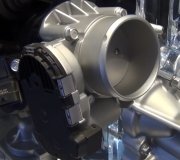Hi orrkid. Welcome back to the forum. Voltages on the automatic idle speed motor don't mean anything. The Engine Computer pulses two pairs of electromagnets with voltage to position the armature which is on a screw thread that retracts the pintle valve. The easiest way to tell if it is working is to observe if there is a nice idle flare-up to around 1500 rpm for a second or two when you start the engine. If there is, the motor is working. Another thing you can do is to remove it and watch it move when you turn the ignition switch on and off.
If the idle speed is still too high after all the things you've done, use a scanner to read the "idle steps" the AIS motor is being commanded to by the computer. There are 256 imaginary steps. Step number 32 is typical for an idle speed of 800 rpm on a normally running engine. If you find it commanding a higher step, say 50 or more, the computer is requesting the higher idle due to a sensor reading, possibly a defective coolant temperature sensor, and the AIS motor is responding to that request. If you find the requested step is near zero, the computer sees the engine running too fast and is trying to slow it down. There has to be a vacuum leak yet somewhere. Pinch off vacuum hoses including the large one that goes to the power brake booster to see if one affects idle speed. Although not common, don't overlook a leak past the bushings of the throttle bodies and the manifold tuning valve.
Caradiodoc
SPONSORED LINKS
Wednesday, July 28th, 2010 AT 4:30 PM




